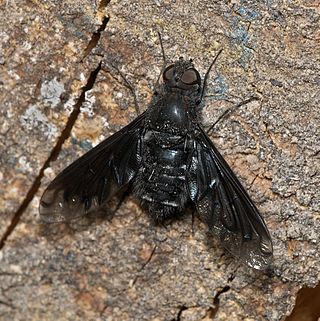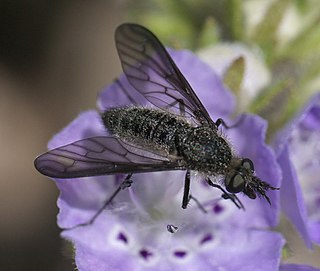
The Bombyliidae are a family of flies, commonly known as bee flies. Some are colloquially known as bomber flies. Adults generally feed on nectar and pollen, some being important pollinators. Larvae are mostly parasitoids of other insects.

Anthrax is a genus of bombyliid flies, commonly known as "bee-flies" due to their resemblance to bees. Most are dull black flies, and are usually small to medium in size, 4–20 millimetres (0.2–0.8 in), and many species have striking wing patterns.

Villa is a genus of flies belonging to the bee-fly family (Bombyliidae). They range in size from 5 to 17 millimetres, and have typically rounded heads. The males of some species have a brilliant mat of silvery patagial scales. About 270 Villa species are found on all continents except Antarctica.

Hemipenthes is a large genus of flies belonging to the family Bombyliidae (bee-flies). There are many described species, distributed throughout the Holarctic realm. These are small to large robust flies with a body length of 5–14 mm. A number of species formerly in this genus were moved to a separate genus, Ins in 2020.

Anthracinae is a subfamily of bee flies in the family Bombyliidae. There are more than 80 genera and 2,000 described species in Anthracinae.

Bombyliinae is a subfamily of bee flies in the family Bombyliidae. There are more than 70 genera in Bombyliinae.
Aphoebantus is a genus of bee flies. There are at least 80 described species in Aphoebantus.

Villini is a tribe of bee flies in the family Bombyliidae.
Chrysanthrax crocinus is a species of bee fly in the family Bombyliidae. It is found in the southwestern United States and Baja California Norte.

Chrysanthrax dispar is a species of bee fly in the family Bombyliidae. It is found in Ontario, Canada, through the eastern United States as far west as Nebraska, south to Mexico.
Chrysanthrax eudorus is a species of bee fly in the family Bombyliidae. It is found in the southwestern United States.
Chrysanthrax arenosus is a species of bee fly in the family Bombyliidae. It is found in Mexico and New Mexico.
Chrysanthrax adumbrata is a species of bee fly in the family Bombyliidae. It is found in California and Baja California Norte.
Chrysanthrax anna is a species of bee fly in the family Bombyliidae. It is found in California and Arizona.
Chrysanthrax arizonensis is a species of bee fly in the family Bombyliidae. It is found in Arizona and Nevada.
Chrysanthrax cautor is a species of bee fly in the family Bombyliidae. It is found in the southwestern United States.
Chrysanthrax juncturus is a species of bee fly in the family Bombyliidae. It is found in the southwestern United States and Mexico.
Chrysanthrax scitulus is a species of bee fly in the family Bombyliidae. It is known from California and Nevada.
Chrysanthrax turbatus is a species of bee fly in the family Bombyliidae. It is found in the southwestern United States from Nebraska to California and Texas.









